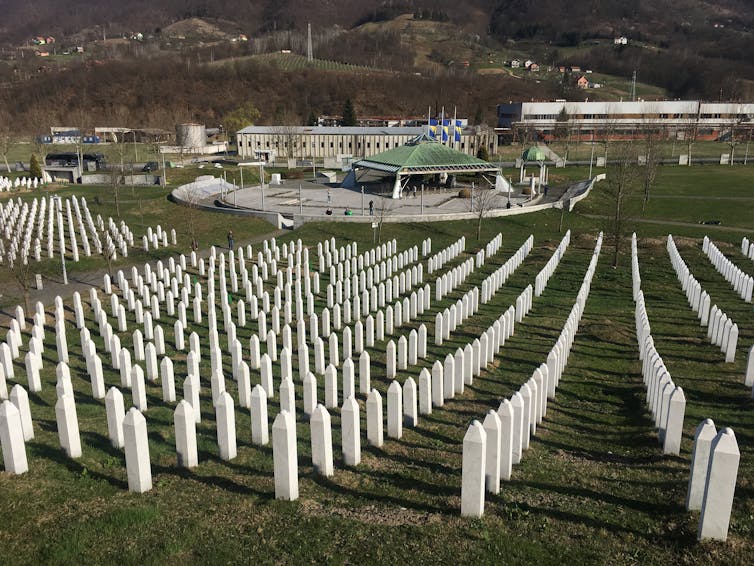
An intense argument is raging over whether what has been happening in Gaza since October 2023 is an act of genocide. It is the subject of a case being heard in the International Court of Justice (ICJ) in which South Africa has accused Israel of committing acts of genocide. The case began in December 2023 but the ICJ has yet to reach a judgment.
The reason the issue is so controversial is that the word “genocide” holds so much power. To be accused of it is to be accused of what is considered in international law to be the “crime of crimes”. International law holds that not only should states not commit genocide, they must also prevent and punish it in their own criminal law. Some commentators would even argue that the use of armed force to stop genocide is acceptable.
Yet the legal definition of genocide is much narrower than is generally understood. That’s why so few events have ever been labelled as genocide as a matter of law. Looking at some of them might help to shed some light on the Gaza controversy.
Read more: Gaza: why it's difficult to reach a legal judgment of genocide against Israel
Genocide is about attempting to destroy a group of people. The concept was first defined in 1944 by the Polish-Jewish lawyer Raphael Lemkin, in response to his horror at the mass killing of ethnic Armenians by the Ottoman Empire amid the first world war as well as – of course – at the atrocities of the Nazis before and during the second world war.
Sign up to receive our weekly World Affairs Briefing newsletter from The Conversation UK. Every Thursday we’ll bring you expert analysis of the big stories in international relations.
It was such a novel concept that it was not prosecuted in the post-war trials of the surviving leading Nazis in Nuremberg. Instead, for their role in the Holocaust, the defendants were charged with “crimes against humanity”. And to this day, in the Rome statute of the International Criminal Court, there is a close relationship between the crime of genocide and crimes against humanity. The Rome statute uses the definition of genocide agreed in the 1948 genocide convention, which was negotiated after the considerable efforts of Lemkin to bring attention to his new concept.
Despite the crime of genocide being established in 1948, the first international conviction for genocide was not until 1998. The International Criminal Tribunal for Rwanda found Jean-Paul Akayesu, a local politician, guilty of genocide as part of the extreme violence by ethnic Hutu against (mostly) minority ethnic Tutsis in 1994. Over the course of around 100 days around 800,000 people were killed.
The mass killing was instigated at the highest levels of the Rwandan government after Tutsis were accused of killing the president of Rwanda, Juvénal Habyarimana, by shooting down a plane that was carrying him and the president of Burundi, Cyprien Ntaryamira. Both men were Hutus.
The response to this was clearly a genocide, but surely there must have been other post-war genocides before this, you might think?
Limitations of genocide
Under the leadership of Joseph Stalin, millions of people died or were killed in famines, executions and prison camps across the Soviet Union. Yet, these deaths do not fall within the 1948 definition of genocide because they were generally not aimed at groups defined by nationality, ethnicity, race, or religion. Only those four groups are protected in the genocide convention.
The same goes for murders committed by the Khmer Rouge – the radical communist regime of Pol Pot that ruled what is now Cambodia from 1975 to 1979. The regime was responsible for the deaths of between 1.5 and 3 million people. But the hybrid criminal tribunal set up in 1997 to judge these events has only been able to find that the killing of minority Vietnamese and Cham victims counted as genocide. The majority of those that the Khmer Rouge targeted for killing were fellow Cambodians selected for being “intellectuals” or were otherwise thought to oppose the regime.
The choice of protected groups in the genocide convention was the result of political horse-trading between different factions, as the cold war was gaining in intensity. There was a tension between protecting enough groups, and agreeing a treaty that enough states would actually sign.
The atrocity of Srebrenica
The International Criminal Tribunal for the Former Yugoslavia (ICTY) and the ICJ have held that Bosnian Serbs committed genocide against Bosnian Muslims in the town of Srebrenica in what is now Republika Srpska in Bosnia and Herzegovina in 1995. The Bosnian Serb army killed around 8,000 men and boys, and secretly buried them. They detained, treated badly and then expelled the remaining women.

The ICTY has held, beyond reasonable doubt, that across Bosnia and Herzegovina there was a “strategic plan” to “link Serb-populated areas […] together, to gain control over these areas and to create a separate Bosnian Serb state, from which most non-Serbs would be permanently removed”. It also found that this plan “could only be implemented by the use of force and fear”. Yet, apart from at Srebrenica, genocide has not been proved in the former Yugoslavia.
The issue here was not identifying a protected group, but a lack of evidence that the mass killings of non-Serbs were carried out as an end in themselves and not “just” to make them flee (something which is often called “ethnic cleansing”). This is because for a killing to be genocidal, it has not only to be carried out intentionally, but also to show the “special” intent to physically or biologically destroy a protected group.
The problem is that – in the absence of an admission or a bundle of incriminating documents – then such special intent can only be inferred from the facts if it is the only reasonable inference that could be made.
Why Gaza is controversial
Should the definition of genocide be expanded to cover a greater range of protected groups, either by amending the genocide convention or by creative judicial interpretation? Should it be easier to infer the existence of genocidal intent from a pattern of facts? Both are important questions.
Yet, until they are answered in the affirmative, it will remain difficult in law to apply the label of genocide even to the most egregious of mass killings. The labels of “war crimes” and “crimes against humanity” are more easily applied, but the “crime of crimes” remains elusive.
James Sweeney does not work for, consult, own shares in or receive funding from any company or organisation that would benefit from this article, and has disclosed no relevant affiliations beyond their academic appointment.
This article was originally published on The Conversation. Read the original article.







